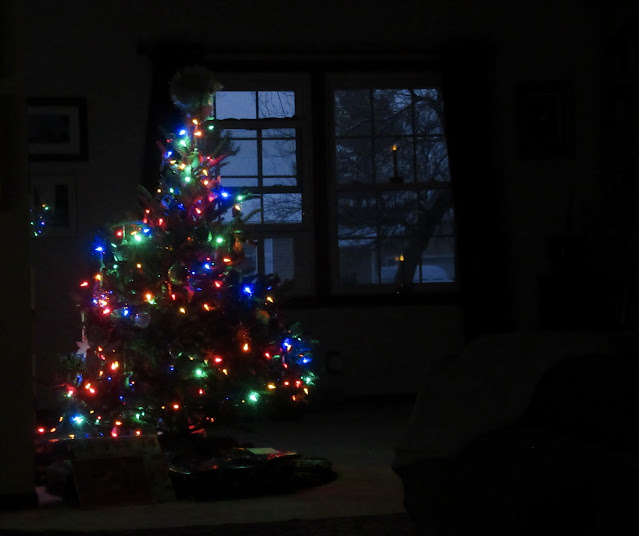12/19-snow started late in the afternoon and came down at a pretty good clip.
It was as beautiful of an evening one can have when you live in snow country. For a time, it was snowing lightly and with barely a light wind, the flakes fell lazily. Inside, the fireplace, candles and tree were aglow. Good music, good food and drink and good company!
12/20-by morning we had received 3-4" of snow. The wind had picked up and was blowing out of the North.
I bought cracked corn for the turkey bros and it turns out many birds like it as well. By 10am, the Diner was hopping-squirrels and a variety of avians-redbirds, jays, titmice, sparrows, finches, chick-a-dees, nuthatches and juncos were visiting. It continued to snow on and off all day.
12/21-Solstice. The cold front arrived bringing a bright, sunny day for the first day of Winter.
Yay Solstice! We're headin' for Spring!
12/22-It got down to +7° overnight but the day was sunny. At the Diner, a turkey and a squirrel visited the buffet.
Inside, it was snug. Buddy enjoyed the sunlight streaming into the library.
꩜
Some holiday fun facts:
Iceland's Yule cat
 | |
| LeksaArt |
From Wiki: The Yule cat, also called Jólaköttur and Christmas cat is a huge and vicious cat from Icelandic Christmas folklore that is said to lurk in the snowy countryside during the Christmas season and eat people who do not receive new clothing before Christmas Eve. In other versions of the story, the cat just eats the food of people without new clothes. Jólakötturinn is closely associated with other figures from Icelandic folklore, considered the pet of the ogress Gryla and her sons, the Yule Lads.
The first definitive mention of the Yule cat is from an 1862 collection of folklore by Jon Arnason, who was an Icelandic author, librarian, and museum director who made the first collection of Icelandic folktales. It was described as an evil beast that would either eat those who did not get new clothes fo rChristmas, or eat their "Christmas bit" (an extra portion of food given to residents of a farm). Jón gave no source for either story.
The Yule cat was traditionally used as a threat and incentive for farmworkers to finish processing the wool collected in the autumn before Christmas. Those who took part in the work were rewarded with new clothes, but those who did not would get nothing and thus would be prey for the Yule cat.
꩜
Singer Mariah Carey receives an estimated $2.5-3 million in royalties annually for her 1996 song "All I Want For Christmas Is You". A rare lottery winner in the entertainment world. Good on her!
꩜
The song "Jingle Bells" was originally a Thanksgiving tune. James Lord Pierpont composed the song in 1850 for his Thanksgiving Sunday School class. Its first title was "One Horse Open Sleigh" referring to New England sleigh races that were popular at the time.
꩜
Apples were among the first Christmas tree decorations:
Since the 1600's, the Catholic Church has celebrated the feast day of Adam and Eve on December 24th. The Church considers Adam and Eve to be saints who repented of their sins and lived holy lives. The feast day of Adam and Eve was celebrated alongside the Paradise Play, which depicted the story of creation and the fall of man. A "Paradise Tree" was central to the play, and people would hang apples on the tree to symbolize the forbidden fruit. The Paradise Tree is thought to be the origin of the Christmas tree. The Roman Church discontinued the Feast of Adam and Eve and the practice of the Paradise Tree, which was renamed the Christbaum or Christ Tree in Germany.










No comments:
Post a Comment